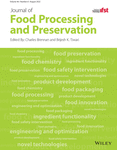Dynamic changes of color, volatile, and non-volatile components during mechanized processing of green tea
Abstract
The quality formation of green tea is closely related to the mechanized processing. Numerous papers involved with tea processing have been reported to optimize tea production. Nonetheless, there are seldom reports about the changes in chemical composition in green tea during mechanized processing. In this paper, the dynamic changes of main quality components in green tea during mechanized processing were analyzed with fresh leaves of tea tree variety (E-Cha No. 10) as raw materials. The content of tea polyphenols and free amino acids showed a downward trend during mechanized processing and decreased significantly during the fixing and drying stages. The content of soluble sugar increased first and then decreased during processing, reaching the maximum value after rolling. The content of total chlorophyll (Chl), chlorophyllide (Cd) a and b, and pheophorbide (Po) a and b displayed a decreasing trend during processing, but the content of pheophytin (Py) a and b showed a significantly increasing trend. The number of aroma type of tea leaves increased successively during the process of fixing, initial drying, and shaping, while the total amount of aroma declined significantly from fresh leaves to fixed leaves. The aroma types of tea leaves after fixing were relatively similar, which demonstrated that fixation was the basis of aroma formation in green tea. These results are conducive to understanding the impact of processing stages on tea quality and provide a powerful basis for the process optimization of green tea.
Practical applications
We found tea processing procedures have a great impact on the quality and composition of green tea (color, volatile, and non-volatile components), especially in the fixing process, which is conducive to the understanding of dynamic changes in main components of green tea during mechanized processing and has practical significance for the optimization of production parameters of green tea.
CONFLICT OF INTEREST
The authors declare no competing financial interest.
Open Research
DATA AVAILABILITY STATEMENT
The data that support the findings of this study are openly available in figshare at http://doi.org/[doi], reference number [reference number].




